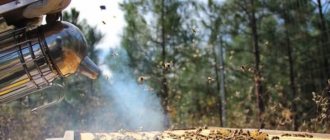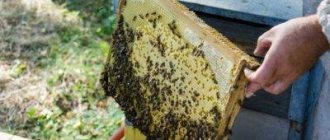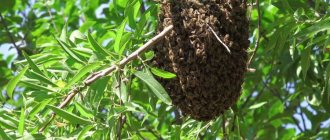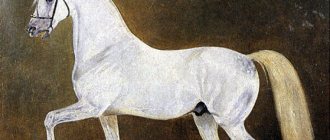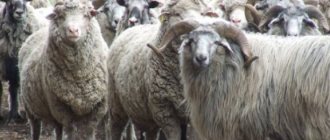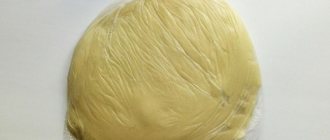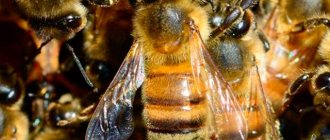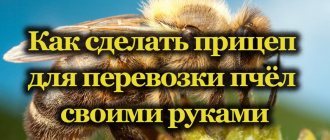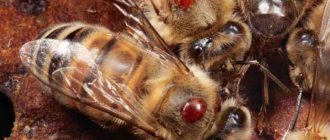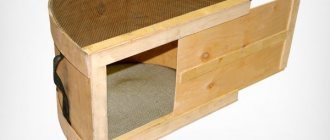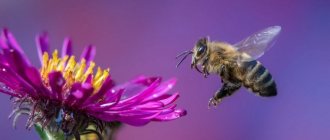The territory of Transcaucasia is characterized by a humid and warm climate, which is reflected in the breed characteristics of apiary insects. Other aspects of the area that are important for the economy are short winters and sudden changes in weather. The Caucasian bee easily tolerates the climate of mountainous regions, temperature, rain, and wintering. The breed is characterized by qualities that are manifested in caring for the uterus when there is a lack of food.
Breed characteristics
| Color | In most mountain bee populations it is silver-gray, taupe, with no yellow or orange at all as seen in the more familiar breeds. But yellow and orange colors are found in the North Caucasian, Dolinnaya, and Iranian populations. |
| Worker bee weight | 85…90 mg |
| proboscis length (average), | 7.2 mm (maximum – 7.5 mm is found in the Megrelian population of this breed) |
| Uterus weight, mg | 180 (on masonry - up to 200) |
| Uterus performance during sowing | 1000…1600 eggs per day |
Populations
Several populations of the gray Caucasian bee should be distinguished.
Abkhazian
More often, beekeepers breed this population in the valleys of Abkhazia and mountainous regions. The characteristics of insects are their peacefulness, ability to work, tolerance to low temperatures and moderate swarming. It is also worth noting its excellent nectar-collecting ability. Bees fly out of the hive early in the morning and return home late.
Gurian
This type of bee is common in Western Georgia. Their distinctive feature is their long proboscis (about 7.5 mm). This unique property allows you to extract nectar from the most inaccessible areas of honey plants.
Experts have identified the tendency of bees to survive harsh winters. Therefore, they are ideal for areas with harsh climatic conditions.
Iranian yellow
Distributed in Iran, Armenia, Azerbaijan. It is also bred in Abkhazia and Georgia. In the Russian Federation, insects live only in apiaries in the central regions, because bees do not like long winters.
The bee's body is gray without stripes. Collects nectar even at temperatures below +10 degrees. But in spring, the departure process is delayed.
Among the positive qualities is restlessness. However, the insect is susceptible to nematosis and other diseases. Also during the wintering period it consumes a small amount of food. Bees fiercely defend their nests.
Valley yellow
Yellow stripes are visible on the insect's abdomen. Tolerates hot heat very well. He feels most comfortable in Iran, Georgia, and Armenia. It has a yellow-gray color. On examination he does not show aggression. Continues collecting nectar even in bad weather.
Among the characteristics of the breed, it is worth highlighting its low winter hardiness, so it is better to grow it in areas with a mild climate. Harvest pollen and propolis in sufficient quantities. They survive transportation well.
Disadvantages include high growth, a tendency to disease, and the production of a small amount of wax.
Megrelian
An excellent option for the northern regions of the Russian Federation. The body color of the insect is silver-gray without yellow splashes. The length of the proboscis can reach 7.5 mm, which affects the bee’s ability to obtain nectar from clover. They are hard-working and actively protect their hives from uninvited guests. Insects with low swarming ability.
Kabakhtapinskaya
This subspecies of Caucasian bees tends to live in the mountains of Azerbaijan. Body color is gray. Differs in proboscis up to 7 mm. A special feature is the high fertility of the queens. Able to withstand temperature drops in winter down to -25 degrees.
There's always honey
The gray mountain Caucasian bee collects pollen and nectar from everything that can produce it. On average, from one hectare of area, insects are able to collect up to 30 kg of honey from at least a weak honey. In the course of studies conducted back in the days of the USSR, it is noted that in forest conditions the breed showed results of 22 kg per family, in steppe conditions - about 60 kg.
This is interesting. How many eyes does a bee have and what spectrum of color vision does it have?
Honey is amber in color, often with a large admixture of pollen grains. The product crystallizes quickly. There is information that the honey of this breed is very dark in color. It is not true. When collected from a sunflower or acacia, the honey obtained is the same as from other species. The difference is the honey seal: it is really dark, “wet”, flat.
All breeds can have dark honey if it is pumped out after wintering or from old honeycombs that are more than 3 years old. But this is the result of the work of the beekeeper, not the bee.
When compared with other breeds, in the absence of available honey plants for more common breeds, the Caucasian bee will be a record holder for harvesting in such conditions: it loves forbs and is able to work in the heat (unlike other common breeds).
During active honey collection, the family directs its attention precisely to the process itself, flooding the maximum of brood cells, and thereby limiting the uterus in the rate of egg laying. With this mechanism, the breed regulates itself: the family maintains a balance of food (which is always in short supply) and numbers (which the queen is constantly trying to increase).
The nectar that insects select from plants in the mountains is low in sugar content. The Caucasian breed of bees is characterized by activity and high speed of flight from plant to plant. Bees do not specifically focus on sources of nectar.
Content Features
Gray mountain Caucasian bees tolerate transportation well and are suitable for keeping in pavilions, as well as for areas with poor honey yield, where there are few honey plants. But it is important for the beekeeper to know about all the features of keeping this breed.
Nutrition
The main diet for bees in the summer is nectar from flowering plants. They are called honey plants. There are also pollen carriers that bees need as sources for collecting pollen. Given the flowering time of plants, bees can feed almost all year round.
But feeding them in winter is vitally important. Feed should be prepared in advance.
When is complementary feeding not needed?
Some experts believe that feeding insects is not necessary, while others argue that without it the normal functioning of bees is impossible. This factor is influenced by several nuances:
- First of all, the beekeeper inspects the hives and calculates how much honey should be prepared for the winter period. If there is enough of it, fertilizing may not be necessary. Otherwise, you should start preparing food.
- It is important not to overfeed the bees. Otherwise, scarring of the uterus will occur prematurely. Fertilizing is also necessary in case of rapid crystallization of honey. Insects will be deprived of the ability to fully process honey, and they will require additional nutrition.
- Until the beginning of February, insects behave passively and hardly eat. From the last weeks of February, the queen begins to darken and the bees become more active and feed the brood. As a result of energy consumption, to maintain the desired temperature, you need to take care of adequate feeding.
How and what to feed bees?
In order for the nutrition of Caucasian bees to be effective and balanced, it is important to consider several ways to feed them:
1Sugar-honey dough
It is mixed in its pure form. Sometimes it is advisable to add medical components. To prevent drying and hardening, the dough mass is placed in a cellophane bag, holes are made at the bottom from where it slowly flows out - this will make it convenient for the bees to consume it.
2Sugar syrup
First of all, you should prepare the hives by placing a couple of incomplete frames in the middle for the bees to deposit the produced syrup. In winter, they will be able to consume processed syrup, and in the spring, with the appearance of brood, the honey collected by the bees will remain in the cells.
For 3,000 individuals, about 2 kg of honey will be required. In this case, honey obtained from syrup should make up no more than 30% of the total mass. They are fed with sugar syrup from the second ten days of August to the beginning of September.
To prepare it, you can take beet or cane sugar without impurities. Boiled water is left to stand for a couple of days. The resulting precipitate is poured off. The syrup should be thick, do not boil it and make sure that the sugar does not burn. Liquid food will be difficult for the bees to process and they will become weak, and crystallized sugar or burnt syrup will negatively affect the health of the bees.
Some beekeepers add some pine needles to the syrup to protect their hives from mites. It will also become an additional source of nutritional components.
For one family, you can add a fresh chicken egg to the sweet feed, which is considered an irreplaceable source of protein. It is shaken well and passed through cheesecloth.
In the autumn-spring period, rejected frames are pulled out of the nests. They are unpacked and placed in front of strong bee swarms. When honey crystallizes in the comb, it can be melted with warm water and returned to the nest for feeding. When honey has soured, you should not give it to bees.
Compared to other insect species, the Caucasian Gray Mountain breed consumes a larger amount of food than other species. Therefore, it is important to take care of the amount of syrup and dough in advance. In the northern regions, feed consumption per bee colony doubles compared to the southern regions.
Conditions of detention
Beekeepers involved in breeding the gray mountain Caucasian bee need to remember the key features of caring for it:
- After wintering, with the onset of a consistently high temperature (not lower than +7 degrees), the hives are taken out of the winter hut.
- Carefully inspect the bottoms and clean them of debris and debris.
- If necessary, the bottom is replaced with a dry, disinfected one.
- Bee colonies and food availability are also inspected. If there is a shortage of it, beekeepers place sugar syrup or sugar-honey dough on the frames.
- They inspect the frames with the brood and clean it. At the same time, it is very important not to combine healthy families with weak ones that show signs of illness.
- It is unacceptable to use honeycombs with brood from diseased swarms.
- It is necessary to install drinking bowls in the apiary, which should contain fresh salted water.
- When stable warm weather sets in, the nest is expanded.
- Disinfection of hives is carried out with fire or steam.
Frost resistance of Caucasian women
Purebred Caucasian women have high frost resistance. The ability of bees to withstand winter well is influenced, in particular, by the physiological changes that occur in the body of insects in the fall. Therefore, it is during the autumn period that they tend to consume a lot of pollen.
It has been noted that gray bees survive the cold season well due to their ability to accumulate not only nutrients, but also fat in their bodies.
Taking into account the biochemical characteristics of purebred individuals, we can confidently note the winter hardiness of Caucasian mountain bees, which cannot be said about their crosses. Therefore, only purebred bees should be kept in apiaries.
Features of wintering
With the end of the season, it is not difficult for experienced beekeepers to provide the Caucasian bees with the proper conditions:
- Considering the fact that the gray mountain Caucasian breed of bees has many populations that differ in their level of winter hardiness, it is important to be careful when purchasing a swarm.
- In order for the bees to survive the winter well, it is not advisable to leave sunflower honey in the hives during the cold season.
- In the last days of August, everything is pumped out and sugar is given to the bees. Some experts dilute useful drugs in sugar syrup (for example, Fumagillin).
- The hives must be placed in a well-ventilated area where there is no dampness.
- It is important to ensure that no old dark honeycomb remains. It's better to install new ones. An alternative option is those in which only one generation of insects has been hatched.
- Hives can be placed both outdoors and in winter huts.
Bee diseases
Caucasian women are quite resistant to various bee diseases. But nosematosis and foulbrood can be dangerous.
Advantages
The gray mountain Caucasian bee has the following advantages:
- high immunity against most diseases;
- early departure and work on an unstable bribe until the cold weather;
- it flies out to the bribe with the first rays of the sun, when the air has not yet warmed up, and returns only at sunset;
- non-aggressive towards the beekeeper;
- low percentage of swarming families - 3% (two queens can coexist in a family, the change of queen occurs smoothly);
- tolerates harsh (down to -25°C) but short winters. Withstands open wintering, provided that short-term frosts do not exceed 30...35 degrees;
- they produce a lot of propolis, which they use to seal cracks and entrances;
- They collect nectar from almost all honey plants, even the weakest ones. The average weight gain can be 1.5 kg per day.
This is interesting Formic acid, its use in beekeeping
Queen bee of the Caucasian bee
The fertility of queen bees depends on the subspecies. The average egg laying is up to 1200–1600 eggs per day. For queens, this is considered normal, but not a high value. The number of eggs laid can actually be increased with proper care and sufficient attention. Differences between maternal individuals:
- the beginning of scarlet coloring occurs in January or February;
- It is recommended to install bars to restrict movement;
- normal reaction to transportation;
- brood restriction when workers deviate from this task.
The change of queen bees is calm and peaceful. Two individuals get along well with each other without interfering with the work of a large family. During honey collection, it is recommended to place sheets of foundation in the center of the nest; this will supplement the frame with additional cells for brood.
Flaws
- The honeycombs are poorly built, honey is poured into the brood part (a feature of the breed) - this can be solved by installing a grid that limits the queen’s movement.
- These are thieving bees - they follow the path of least resistance; for them, a foreign hive is primarily a source of nectar.
- Not suitable for long winters.
- Doesn't like dampness.
- Susceptible to the following diseases: nosematosis, honeydew toxicosis and European foulbrood. The only solution is proper care.
- The colony's strength may be compromised by worker bees limiting the queen's sowing area.
- Brood, beebread and honey are often mixed in close areas in the frame.
- On strong bribes it performs worse than other breeds.
- When mixed with other breeds, it loses all its valuable qualities.
Productivity
The Caucasian breed is distinguished by its productivity on meager bribes. With abundant and average honey harvest, individuals lose to almost all types of bees. With a small bribe, insects collect up to 20 kg of nectar, while other breeds collect 11–13 kg.
If there is an abundance of bribes, then the whole family goes to collect honey. The queen bee is limited in food, and the nectar is placed on frames around the edges or in a nest with brood. Then the individuals gradually rebuild the top of the hive. As a result, there is beebread and brood on the honeycomb frames, which makes it difficult to pump out honey, so it is recommended to keep Caucasian bees in beds with 24–26 frames. Multi-level hives are not advisable.
Conclusion
The Gray Caucasian bee breed should be used wisely. For example, it is ideal for use in weak conditions. As a good pollinator, it is advantageous to use in greenhouses, in limited areas for growing weak honey plants that require pollination (for example, legumes).
The breed is strong, designed to survive, but this does not mean that it is absolutely protected from external factors. Like any bee colony, Caucasian sulfur hives require monitoring and care.
This is interesting The drug Timol for bees
Video: apiary, Caucasian bee.
Characteristic differences
Despite their “hot” Caucasian roots, they rarely attack beekeepers. When the hive is manipulated, they do not even stop doing their work.
Another distinctive feature is the earliest start of the summer season among insects. Individuals of the Abkhazian breed finish seasonal work later than all others, which confirms their high productivity and working capacity.
When characterizing Caucasian women, it is worth noting their ability to control the number of eggs laid by the queen, therefore, a beekeeper who sets out to increase the bee colony must supply additional honeycombs, the queen will fill them with eggs the same day.
Low swarming ability (degree of swarm instinct). It is observed in only 7% of families.
They are also distinguished by their high level of enterprise when searching for honey plants and collecting the maximum amount of honey. Caucasian women easily evaluate the quality and concentration of nectar and choose the best, which is why they create honey of the best quality.
A positive characteristic of these bees is their reverent attitude towards their home. The production of a huge amount of wax and propolis is enough to build a strong house. Holes in the hive are also repaired with wax and frames are connected.
How is honey collection going?
The majority of Caucasian bees, resistant to frost, begin to collect honey with the appearance of the first flowers. The end of summer occurs late and depends on the availability of food supply (for example, in the southern regions, wild flowers continue to bloom until the beginning of December). Worker bees leave the hive at dawn when the temperature is low, returning late (after or at sunset).
Insects are constantly looking for new areas with honey plants; high air humidity or drizzling rain do not interfere with nectar collection.
Peculiarities of foraging in the gray mountain bee
High mountain Georgian bees are distinguished by their rapid response to the presence of feeders with sugar syrup. They can detect the presence of sugary substances even if they do not emit any odor, this is important for storing honey.
In obtaining food, it shows thieving tendencies, penetrating into the nests of other species of bees, but it carefully guards its honeycombs.
Lifestyle
Gray Caucasian bees do not like dampness, so they need to provide good ventilation in their hives. Bees are not afraid of the cold. During wintering in the wild, they can easily withstand frosts from -20°C to -25°C. This is due to the fact that the natural habitat of bees is highlands.
During wintering of bees, it is important to ensure that there is no honeydew honey in the hive. Under no circumstances should bees be allowed to overwinter on honey that can crystallize. Frames with such honey should be replaced with frames prepared in advance with honey that does not shrink. Bees can also be fed with sugar syrup.
In the spring you should remove the hives early. Individuals of this species like to fly over early, immediately at the first sinking, when the temperature rises from +3°C to +5°C.
Caucasian bees are well adapted to hot, humid climates. It is believed that Caucasian bees can be effectively used for pollination in greenhouses. However, this assumption has not been tested in practice.
Bees respond well to foreign sources of nectar. They perfectly protect their homes from uninvited guests.
Representatives of this species are not aggressive and have an easy-going and calm character. When inspecting the hive, work on the honeycombs continues.
Gray Caucasian bees are susceptible to nosematosis, European foulbrood, and honeydew toxicosis. But if their living conditions are good enough, then all these diseases can be easily avoided.
Description of the queen bees of the Caucasus
Depending on the subspecies, the egg production of queens ranges from 1000 to 1700 eggs per day. The average figure is 1200-1500 eggs per day. Uterus require special care. The better care you take, the better egg production.
The weight of an infertile uterus is 185 mg; a fetal uterus can weigh more than 200 mg.
Two queens can easily be in the hive without interfering with the work of the rest of the bees. The scarring of the queens begins at the end of January. It is important to control this process when expanding the hive with new frames.
Egg production of the uterus
The main housewife in the hives where gray Caucasian insects live, of course, is the queen. Before fertilization, her weight becomes no more than 180 grams. After mating games with drones, she gains up to 200 g of weight. By the way, the female begins to lay offspring in the middle of winter, with the onset of the new year - so beekeepers need to remember this and do not forget to add frames for expanding the family. If we compare the egg production of female Caucasian bees with the rest, it is not very high - on average, a representative of this breed lays from 1100 to 1500 eggs per day. But during the period of active honey collection, hymenoptera have to fill the cells intended for future offspring with wax - after all, now the main mass of bees should not be engaged in potential “cubs”, but direct their activity to collecting nectar. At these moments the queen slows down the rate of egg laying.
Queen bee
Appearance
The Caucasian breed has a grayish tint; in the sun, a silvery tint appears. Some selected subspecies have yellow patches, but there are no bright stripes of this color either on the body or on the abdomen.
The weight is small, on average ranging from 75 to 90 mg. But against the background of the miniature body, a long proboscis protrudes, which can reach 8 mm. This is one of its distinctive features. The queen weighs more than 200 mg during the fetal period, after which it weighs no less than 180; it can easily be found in the hive among the working individuals.
Honorary beekeeper of the Krasnopolyanskaya station - Lidiya Frolovna Lobanova
Let me introduce you to Lydia Frolovna Lobanova, a mentor, an honorary beekeeper, a labor veteran, and a scientist who was lucky enough to work together with academician Vinogradov, with whom they had a huge influence on the development of beekeeping in the high-mountain village of Aibga. All subsequent managers of the bee farm at the Krasnopolyansk Experimental Station had the pleasure of working with her - a specialist who worked for the benefit of the Krasnopolyanskaya station and the famous high-mountain apiary No. 36 from the first days of its foundation and who knows everything about breeding and keeping bees in our region.
We were lucky enough to be the owners of the first publications in the media about Lydia Frolovna Lobanova, made in the distant Soviet times. And we are happy to share these rare notes with our clients so that they can see for themselves what a great beekeeper we were lucky enough to work with. This article is our tribute to the legendary grandmother from Sal Aibga.
Lidia Frolovna Lobanova came to work in beekeeping back in 1948, having only a month's beekeeping courses behind her and a great desire to devote her life to breeding the gray mountain Caucasian bee. In the post-war years, it was necessary to put all sectors of the national economy on their feet, and this was very difficult. Everyone who could and knew how to work with bees did everything possible to organize the work of apiaries in Sochi. And the exceptional diligence of the owners of bee farms and their workers, naturally, yielded results. Extensive experience in practical work allowed Lidia Frolovna Lobanova to achieve high production indicators, thanks to which in 1975 her apiary became part of the Krasnaya Polyana agricultural enterprise.
What can best say about the level of a specialist, if not his awards and recognition? The work of Lidia Frolovna Lobanova in the field of development of bee nurseries for breeding queen bees has been repeatedly awarded with high state awards, certificates and diplomas, valuable prizes and monetary rewards. From the state for her achievements in breeding queen bees in high-mountain apiary No. 36, Lidiya Frolovna Lobanova received a VAZ 2101 passenger car. It was a completely deserved victory. Since it was in her apiary and under her leadership that the almost impossible at that time was accomplished: for seven years in a row the plan was exceeded by 250%. Later, Lidia Frolovna deservedly became the owner of two motorcycles with a Dnepr sidecar and diplomas, proving through personal experience that it is more than possible to exceed the three-year plan by 200%. And how many household appliances, refrigerators and televisions were received for her progressive methods of breeding queen bees in the apiary - in a word, even her household lost count of all the prizes and awards this amazing woman received
On our website, of course, we will pay attention to her awards and diplomas, displaying them in our gallery for everyone to see
They say that the secret of the high performance of Lidia Frolovna Lobanova’s work lies in the family contract. All her life, hand in hand in this difficult task, her husband Anatoly Mikhailovich, son Yuri and daughter Olga worked with her in the apiary. The family spent so much time in the apiary that the children almost grew up on it, spending all weekends and holidays in a picturesque place high in the mountains, on the slope of steep Aibga. The younger generation selflessly helped their parents, absorbing practical experience and valuable knowledge about bees, and after so many years they cannot imagine life without breeding this truly golden bee and continue the family business.
In 2022, Lidia Frolovna celebrates her 70 years of work experience. To this day, Lidia Frolovna is still an honorary beekeeper and bees remain her life’s work. She tries to pass on her truly enormous experience to children so that the glorious traditions of high-mountain beekeeping do not disappear. Particularly helpful in continuing her business is her daughter Olga Anatolyevna Dobshinskaya (Lobanova), the direct organizer and owner of the new type of Aibginsky, whose success in the field of breeding mountain bees has also been recognized with numerous state awards. We will also talk about her work in subsequent articles.
Collecting honey from a gray mountain bee
Gray mountain bees store a large amount of collected nectar as reserve food. Already in the spring they make solid honey belts in the honeycombs of the nest, surpassing other bees in this. During mass honey collection, colony growth in gray mountain bees slows down, so such conditions contribute to increased accumulation of honey.
Beekeepers are attracted by the resilience, endurance, and unpretentiousness of gray mountain bees.
Sealing honey from a gray mountain bee
High mountain Georgian bees seal the honey in the combs, closing the lids tightly so that no air gets under them, which is why they are dark in color. And Central Russians cover the caps so that a layer of air remains between the cap and the layer of honey. That's why the honeycomb is white on top.
The gray mountain bee is not aggressive, does not get annoyed by the presence of people, and does not sting.
Gray mountain bees allow people to stand nearby and observe their activities even as the queen continues to lay eggs. In this case, you can safely do without the use of protective equipment.
Habits of Caucasian women
Among the main habits of mountain bees:
- react neutrally to inspection and intervention (without damage to the hive) from the beekeeper;
- prone to theft;
- quick transition to work;
- constant activity, especially during the honey harvest period, when there are few honey plants nearby, they try to find them in every possible way;
- They are not prone to playfulness.
The desire to steal honey from third-party hives, often from other families in neighboring apiaries, is due to the fact that hardworking bees try to find as much nectar as possible and bring it to their house. This type of behavior should not always be considered a disadvantage.
Wintering
Since not all varieties of insects withstand negative temperatures well, it is necessary to clarify the level of frost resistance even at the stage of purchasing a swarm. For the winter, honey obtained from sunflower flowers must be placed in the hive. After the final summer pumping of collected honey, it is recommended to add sugar syrup with additives (for example, fumagillin, which reduces the risk of nosematosis).
Hives should be stored in a room with stable ventilation and normal humidity levels. In the southern regions, wintering in the open air is allowed (both with additional insulation of the walls and without modification). It is not recommended to leave darkened honeycombs inside the house; such frames should be removed and new ones installed or those used for hatching one generation of insects. Wintering indoors ends when the average daily air temperature is not lower than +7°C.
Pros and cons of the most popular bee breeds
Today there are more than 20 thousand species of bees in the world, including almost 2 thousand that exist in the fauna of Europe. Many of them are still little studied. There are several dozen breeds of honey bees living in colonies in nature or in apiaries. Under the influence of evolutionary processes and climatic features of the area where this or that breed of insects originally lived, they developed and fixed certain morphological characteristics and behavior. This means that insects, adapting to existing circumstances, acquired differences unique to them in:
- productivity (when collecting nectar and pollen, producing propolis and wax);
- susceptibility to disease;
- wintering tolerance;
- bee colony development;
- predisposition to swarming;
- construction of honeycombs;
- in the specificity of behavior:
- etc.
Therefore, it is important for a beekeeper to have an idea of the different breeds of honey bees and take into account their characteristics when purchasing for his apiary. The right choice will have a positive impact on the productivity of the bee farm as a whole, will reduce the risk of bee death and will make the work of the beekeeper easier.

